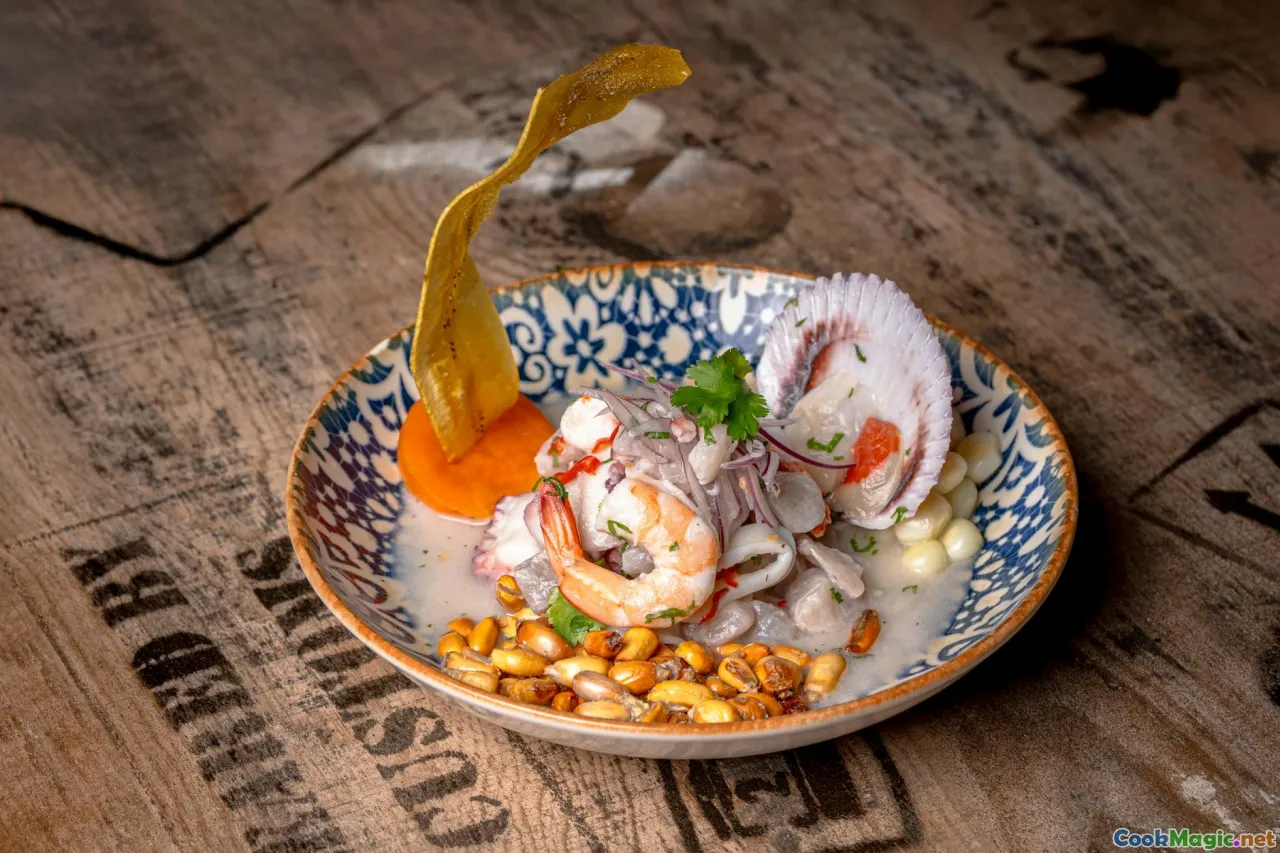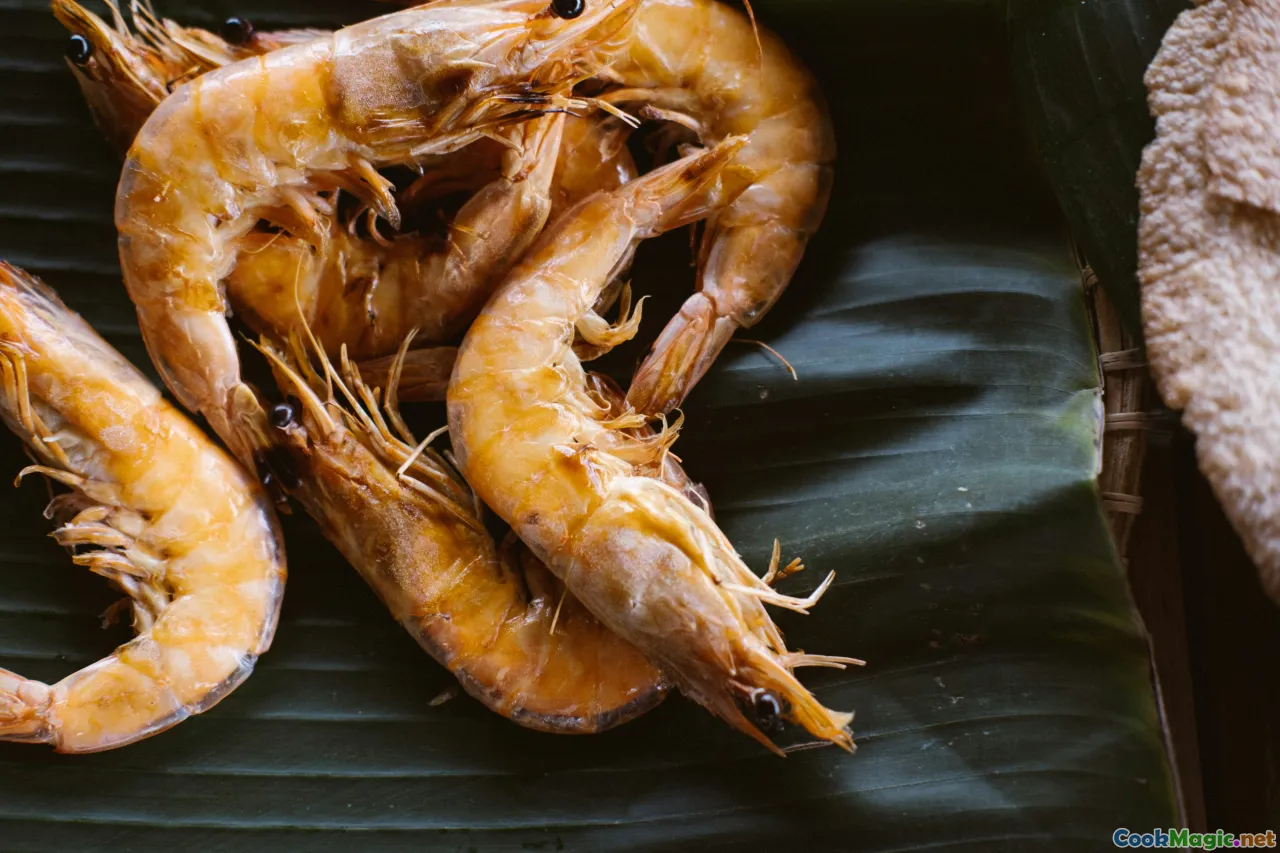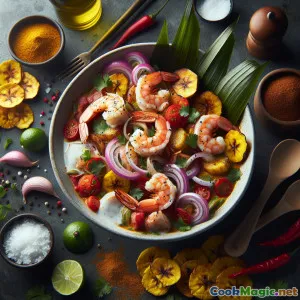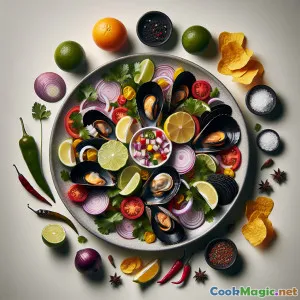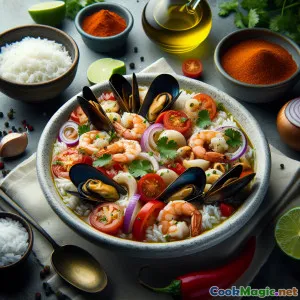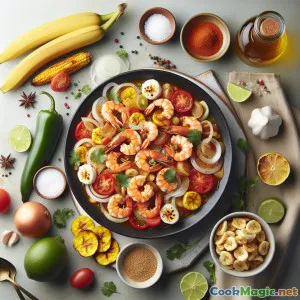
厄瓜多尔虾仁香蕉炖菜配烤玉米
(Ecuadorian Shrimp Plantain Stew with Toasted Corn)
(0 评论)食材
-
400 grams 新鲜虾
(Peeled and deveined, tails on for flavor)
-
2 medium 青蕉
(Peeled and chopped into chunks)
-
1 large 白洋葱
(切成细丁)
-
2 medium 西红柿
(籽和细碎)
-
1 small 红甜椒
(切丁)
-
2 tablespoons 阿奇奥特(胭脂树)油
(Gives color and subtle flavor)
-
3 large 大蒜瓣
(剁碎的)
-
2 tablespoons 花生酱
(Smooth, unsweetened for authentic taste)
-
800 ml 鱼或虾高汤
(Or use chicken stock as alternative)
-
0.5 bunch 香菜
(切碎)
-
80 grams 烤玉米粒(Cancha, Chulpe或玉米坚果)
(用于装饰和脆感)
-
1 teaspoon 盐
(根据个人口味)
-
0.25 teaspoon 黑胡椒
(新鲜磨碎)
-
1 whole 青柠檬楔
(用于上菜)
(Peeled and deveined, tails on for flavor)
(Peeled and chopped into chunks)
(切成细丁)
(籽和细碎)
(切丁)
(Gives color and subtle flavor)
(剁碎的)
(Smooth, unsweetened for authentic taste)
(Or use chicken stock as alternative)
(切碎)
(用于装饰和脆感)
(根据个人口味)
(新鲜磨碎)
(用于上菜)
营养
- 份量: 4
- 每份大小: 1 碗 (250克)
- Calories: 520 kcal
- Carbohydrates: 58 g
- Protein: 26 g
- Fat: 18 g
- Fiber: 7 g
- Sugar: 8 g
- Sodium: 1020 mg
- Cholesterol: 140 mg
- Calcium: 95 mg
- Iron: 2.2 mg
制作步骤
-
1 - Prepare Plantains:
Peel and chop green plantains into medium chunks. Place in a food processor or blender with 200 ml of stock and pulse until a rough, starchy paste forms.
-
2 - Sauté Flavor Base:
Heat achiote oil in a large pot over medium heat, add diced onion, bell pepper, and garlic. Sauté 4-5 minutes until soft, then add chopped tomatoes and cook another 3 minutes.
-
3 - Build the Stew Base:
Add the plantain paste, peanut butter, and remaining stock to the pot. Stir to combine, then bring to a simmer on low heat.
-
4 - Cook to Thickness:
Stir frequently; simmer until stew thickens (plantain will break down, making a rich, creamy texture). Add salt and pepper.
-
5 - Add Shrimp:
Stir in shrimp and half the chopped cilantro. Gently poach shrimp in the thickened stew for 5-7 minutes until just pink and opaque.
-
6 - Finish & Serve:
Taste and adjust seasoning if needed. Ladle stew into bowls, sprinkle with toasted corn and extra cilantro. Serve hot with lime wedges.
Peel and chop green plantains into medium chunks. Place in a food processor or blender with 200 ml of stock and pulse until a rough, starchy paste forms.
Heat achiote oil in a large pot over medium heat, add diced onion, bell pepper, and garlic. Sauté 4-5 minutes until soft, then add chopped tomatoes and cook another 3 minutes.
Add the plantain paste, peanut butter, and remaining stock to the pot. Stir to combine, then bring to a simmer on low heat.
Stir frequently; simmer until stew thickens (plantain will break down, making a rich, creamy texture). Add salt and pepper.
Stir in shrimp and half the chopped cilantro. Gently poach shrimp in the thickened stew for 5-7 minutes until just pink and opaque.
Taste and adjust seasoning if needed. Ladle stew into bowls, sprinkle with toasted corn and extra cilantro. Serve hot with lime wedges.
关于 厄瓜多尔虾仁香蕉炖菜配烤玉米 :的更多信息
Sango de Camarón: Tradition with a Gourmet Twist
The Sango de Camarón is much more than a meal; it’s a representation of Ecuador’s coastal regions and their abundant gifts from land and sea. Traditionally, this stew marries the earthy starchiness of green plantains with the rich savor of shrimp and is thickened to creamy perfection—sometimes leaning nearly to a porridge-like consistency. This unique bowl captures the heritage, the soul, and the warmth of Ecuadorian homes and local markets.
Origins & Cultural Significance
Emerging from Ecuador's coastal provinces, sango was designed partly out of culinary ingenuity and necessity. Plantains, a deeply rooted staple, lend themselves both to thickening and flavor. When seafood like shrimp was plentiful (especially after the fishers’ daily haul), families would prepare sango for both everyday meals and special gatherings, celebrating bounty and sustenance.
Adding peanut butter to the sango is a reflection of the country’s diverse agricultural traditions, yielding a surprisingly harmonious flavor and lush mouthfeel. The inclusion of toasted corn (cancha or chulpe) elevates it, providing contrasting crunch that complements the stew’s creamy base—offering a playful echo of Ecuadorian Andes where such corn snacks are beloved.
Cooking Tips & Customization
- Plantains: Use green (unripe) plantains, as their high starch content is key for structure and thickening. Ripe plantains will make the stew too sweet and soft.
- Achiote Oil: Traditional in Ecuador, achiote imparts a herbal-yellow hue and subtle aroma. If you can’t find achiote oil, infuse regular vegetable oil with achiote paste or coloring.
- Peanut Butter: Opt for unsweetened, smooth peanut butter; it should melt easily and add creaminess. A dab more for peanut lovers won’t hurt.
- Stock Base: Home-made seafood or shrimp stock generates the deepest flavor, but boxed or bouillon-based alternatives can also work (consider reducing additional salt).
- Toasted Corn: For authentic texture, seek cancha/chulpe corn nuts, available in Latin markets. If unavailable, salted corn nuts offer great flavor—don’t skip this!
Unique Aspects
The toasted corn garnish is outside the most orthodox sango de camarón presentations, but it's a delightful, textural contrast borrowed from other Ecuadorian street foods—making each bite an adventure between luscious stew and crisp corn.
Springy shrimp cooked gently at the end ensures tenderness and keeps their natural briny sweetness. Want even more color? A sprinkle of fresh, chopped red amaranth leaves or tiny diced avocado makes a modern flourish.
Personal Thoughts
This dish strikes a bold balance: umami from shrimp, creaminess from peanut and plantain, and crunch from toasted corn. It’s gluten-free, gluten-loving, celebratory, and deeply comforting—a must-try for fans of global stews. In my test kitchen, this quickly became a novel hit thanks to the nutty undertones and cubes of rich plantain, which echo soulful, nourishing—and uniquely Ecuadorian—culinary identity.
Final Serving Suggestion
Serve it on a chilly evening or for a communal table feast. A light cabbage slaw or crisp radish salad is the perfect sprightly side. Always finish with a squirt of lime to highlight those deep flavors.
Once you’ve tried this recipe, you’ll have not only tasted Ecuador but woven a piece of its history into your own kitchen rituals.

